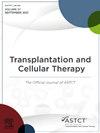Modulators of Relapse Risk after Hematopoietic Cell Transplantation for Adults with Acute Myeloid Leukemia Allografted in Measurable Residual Disease (MRD)-Positive Remission
IF 3.6
3区 医学
Q2 HEMATOLOGY
引用次数: 0
Abstract
Introduction
Measurable residual disease (MRD) before hematopoietic cell transplantation (HCT) identifies adults allografted for acute myeloid leukemia (AML) in remission who are at high risk of relapse and poor survival. The factors that modulate these outcomes are poorly characterized.
Methods
We conducted a single-center retrospective study of adults age ≥18 years with AML in first or second remission with MRD by multiparameter flow cytometry who underwent allogeneic HCT between 5/2006 and 3/2023.
Results
We identified 207 patients (median age: 51 [range: 18-74] years) for study inclusion. Donor sources included 10/10-HLA matched related or unrelated donors (n=146), 1-2 allele mismatched unrelated donors (MMUD; n=24), haploidentical donors (n=11), and umbilical cord blood (n=26). In the whole cohort, 126 (61%) underwent myeloablative conditioning (MAC) while 81 (39%) received non-MAC conditioning. MAC recipients were younger and had lower treatment-related mortality (TRM) scores, though other characteristics (including secondary AML [sAML], first vs. second remission, disease risk, presence of residual cytogenetic abnormalities at HCT, and blood counts before HCT) were similar. With a median follow up of 64 months among survivors, the 3-year relapse incidence was 65% (58-71%) while non-relapse mortality (NRM) was 4% (2-8%) and 12% (8-16%) at 100 days and 18 months, respectively. This translated into 3-year overall survival (OS) and relapse-free survival (RFS) estimates of 34% (28-41%) and 24% (18-30%), respectively. There were no differences in OS, RFS, relapse, or NRM between MAC and non-MAC recipients. After adjusting for TRM scores and conditioning intensity, we found that adverse disease risk (hazard ratio [HR]=1.74 [1.20-2.51]), residual cytogenetic abnormalities at HCT (HR=1.50 [1.05-2.14]), and poor blood count recovery before HCT (HR=2.91 [1.53-5.56]) were associated with increased risk of relapse (table 1). While 3-year relapse incidence for MRDpos patients with intermediate risk disease and normalized cytogenetics at HCT was 61% (34-80%, n = 18), it was as high as 81% (65-90%, n=45) in MRDpos patients with adverse risk disease and residual cytogenetic abnormalities at HCT. In turn, TRM score (HR=1.81 [1.21-2.71]) and non-MAC (HR = 2.37 [1.12-5.02] were associated with increased NRM, and poor blood counts at HCT (HR = 2.01 [1.06-3.79]) were associated with shorter OS. Sex, hematopoietic cell transplantation-specific comorbidity index (HCT-CI), sAML, and second remission had no impact on risk of relapse, NRM, or OS.
Conclusion
In adults with AML allografted in MRDpos remission, additional factors including adverse cytogenetics, residual cytogenetic abnormalities, and poor blood counts at transplant modulate relapse risks. Consideration of these risk factors may inform patient selection and decision making regarding potential risks/benefits of HCT.
求助全文
约1分钟内获得全文
求助全文
来源期刊

Transplantation and Cellular Therapy
Medicine-Hematology
CiteScore
7.00
自引率
15.60%
发文量
1061
审稿时长
51 days
 求助内容:
求助内容: 应助结果提醒方式:
应助结果提醒方式:


